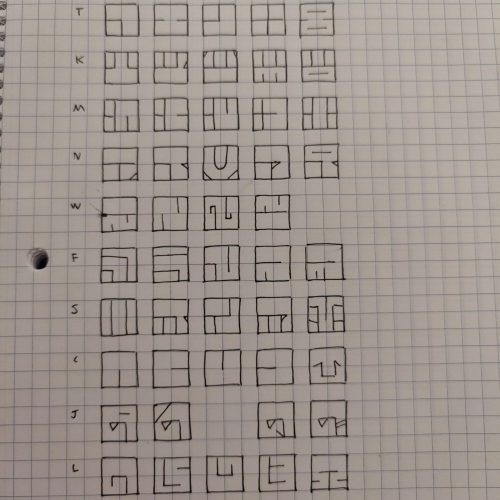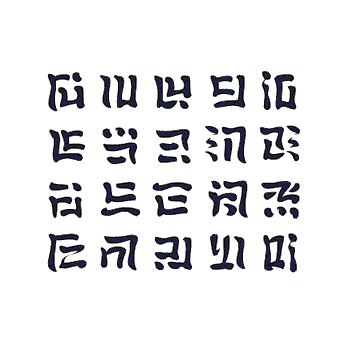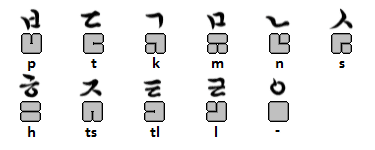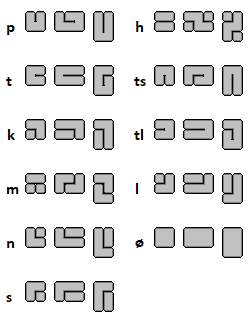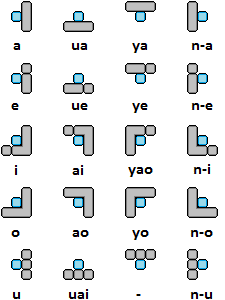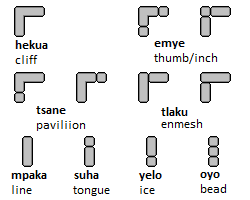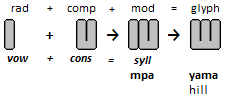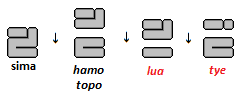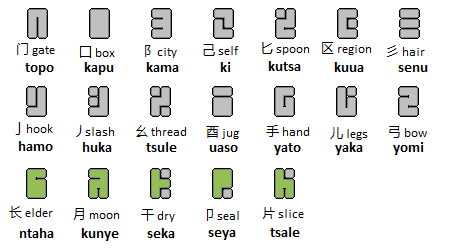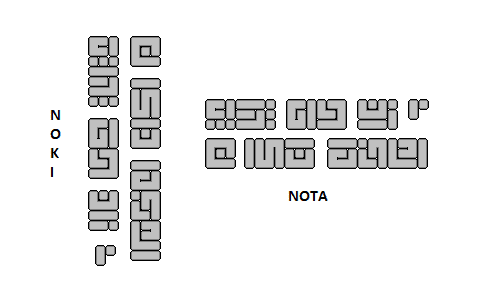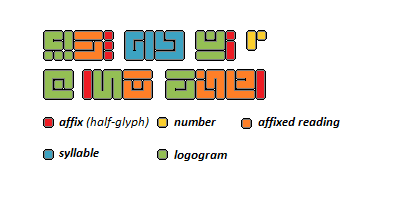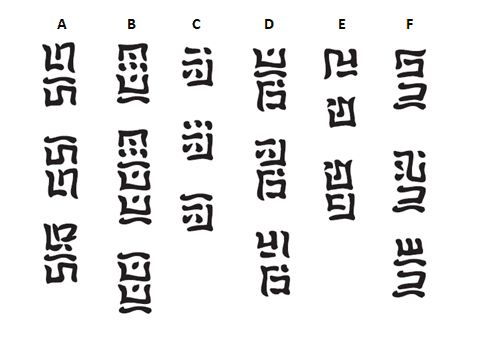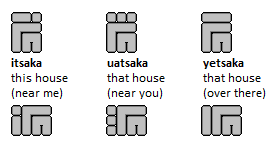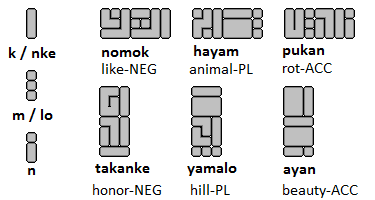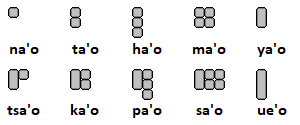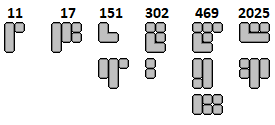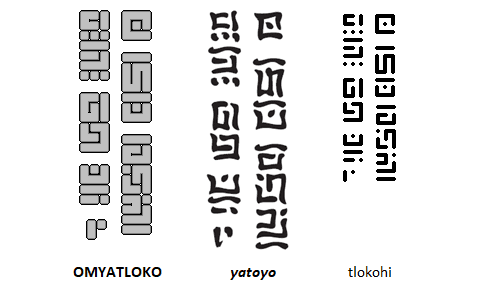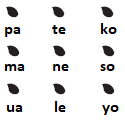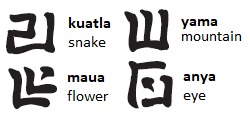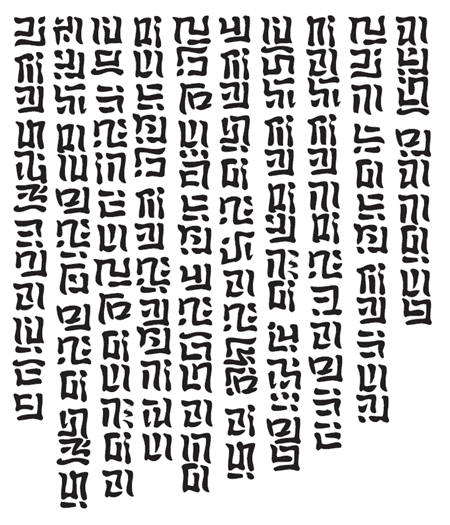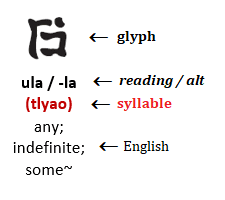Omyatloko Logosyllabary for Kala
Autor: Carl Buck
MS-Datum: 01-13-2023
FL-Datum: 07-01-2023
FL-Nummer: FL-00008E-00
Zitat: Bock, Carl. 2023. “Omyatloko Logosyllabary for
Kala.” FL-00008E-00, Fiat Lingua,
Urheberrechte ©: © 2023 Carl Buck. Dieses Werk ist lizenziert unter
eine Creative Commons Namensnennung – nicht kommerziell-
NoDerivs 3.0 Unportierte Lizenz.
http://creativecommons.org/licenses/by-nc-nd/3.0/
Fiat Lingua wird von der Language Creation Society produziert und gepflegt (LCS). Für mehr Informationen
über die LCS, visit https://www.conlang.org/
Omyatloko Logosyllabary for Kala
The logosyllabary Omyatloko for the Kala conlang.
Developed and created by Carl Buck
A pangram of all syllable vowel markers, and at least one consonant each.
Unless otherwise stated, this work is licensed under a Creative Commons Attribution-ShareAlike 4.0 International License.
1
Omyatloko Logosyllabary for Kala
“What gives any particular element of language its role in the language is not its
superficial physical properties but, eher, the relationships it enters into with
the other elements of the language.” (Sampson, pg 12)
Unless otherwise stated, this work is licensed under a Creative Commons Attribution-ShareAlike 4.0 International License.
2
Omyatloko Logosyllabary for Kala
Omyatloko Logosyllabary ______________________________________________________________ 5
Introduction ______________________________________________________________________ 5
Syllabograms _____________________________________________________________________ 5
Logograms __________________________________________________________________________ 7
Radicals __________________________________________________________________________ 7
Components ______________________________________________________________________ 8
Reading of Glyphs __________________________________________________________________ 8
Writing Direction ____________________________________________________________________ 10
Glyph types ______________________________________________________________________ 10
Contextual Reading _______________________________________________________________ 11
Other Symbols ___________________________________________________________________ 12
Deixis___________________________________________________________________________ 12
Numeral Glyphs_____________________________________________________________________ 13
One through Ten _________________________________________________________________ 13
Higher Numbers __________________________________________________________________ 13
Numerals _______________________________________________________________________ 13
Writing Styles ______________________________________________________________________ 14
Brush Stroke Order ________________________________________________________________ 15
Example ___________________________________________________________________________ 16
Glyph Dictionary ____________________________________________________________________ 17
Collating Order ___________________________________________________________________ 17
Topo (gate) ______________________________________________________________________ 18
Kapu (box)_______________________________________________________________________ 24
Kama (city) ______________________________________________________________________ 25
Ki (selbst) _________________________________________________________________________ 27
Kutsa (spoon) ____________________________________________________________________ 29
Kuua (region) ____________________________________________________________________ 32
Senu (hair) ______________________________________________________________________ 34
Hamo (hook) _____________________________________________________________________ 37
Huka (slash) _____________________________________________________________________ 43
Tsule (thread) ____________________________________________________________________ 46
Uaso (jug) _______________________________________________________________________ 50
Yato (Hand) ______________________________________________________________________ 51
Unless otherwise stated, this work is licensed under a Creative Commons Attribution-ShareAlike 4.0 International License.
3
Omyatloko Logosyllabary for Kala
Yaka (leg) _______________________________________________________________________ 55
Yomi (bow) ______________________________________________________________________ 59
Syllables___________________________________________________________________________ 61
PA _____________________________________________________________________________ 61
TA _____________________________________________________________________________ 61
KA _____________________________________________________________________________ 62
MA_____________________________________________________________________________ 62
NA _____________________________________________________________________________ 63
SA _____________________________________________________________________________ 63
HA _____________________________________________________________________________ 63
TSA ____________________________________________________________________________ 64
TLA ____________________________________________________________________________ 64
LA _____________________________________________________________________________ 64
A ______________________________________________________________________________ 64
References ________________________________________________________________________ 65
Unless otherwise stated, this work is licensed under a Creative Commons Attribution-ShareAlike 4.0 International License.
4
Omyatloko Logosyllabary for Kala
Omyatloko Logosyllabary
Einführung
The “omyatloko” (syllable carving) script is primarily meant to be an epigraphic system, but a
handwritten version is possible, and there is a “text” version as well. It is designed to be reminiscent of
Mayan glyphs, Cuneiform, Japanese Kanji, or Chinese Hanzi. Along with the obvious natural language
inspirations, several constructed scripts have motivated the creation of Omyatloko; Pseudoglyphs,
Kamakawi, Tepat, and Sitelen. The glyphs are logosyllabic, combining about a thousand logograms
(which represent whole words) and 220 syllabograms (which represent syllables).
Syllabograms
The base consonant glyphs were directly inspired by Hangul.
Konsonanten
Each consonant has three forms. The form used depends on the vowel added when making the syllable
glyph. (ø = null consonant) These are arranged in the pataka order, explained below.
Unless otherwise stated, this work is licensed under a Creative Commons Attribution-ShareAlike 4.0 International License.
5
Omyatloko Logosyllabary for Kala
Vokale
Vowel markers are designed to convey articulation of vowels, as well as palatalization or labialization.
Consonantal pre-nasalization and diphthongs are also indicated. The blue squares in the chart below
indicate the position of the consonant glyphs.
Based on the 20 vowel markers, and the 11 consonant components, there are 220 possible
syllabograms, Jedoch, 84 of these are disallowed based on Kala phonotactics. A few good examples
are “lyao”, “ntlu”, and “nho”.
The vowel combination [jaʊ̯] and the consonant [l]; the syllable “lyao” does not occur in Kala, und das
glyph is – bis jetzt – undefined.
The vowel radical for a pre-nasalized consonant followed by the vowel [u] is placed to the left of the
consonant component, in diesem Fall [tl]. The syllable “ntlu” does not occur anywhere in Kala, so the glyph
is used for the word “nyoma”, meaning ‘rice’. It can be interpreted as a “hand cupping grains of rice”, So
it becomes pictographic.
The vowel [ⁿ-o] and the consonant [h]; the syllable “nho” does not occur in Kala, so the glyph is used as
an ideogram for the word “atsi”, meaning ‘angle’.
Unless otherwise stated, this work is licensed under a Creative Commons Attribution-ShareAlike 4.0 International License.
6
Omyatloko Logosyllabary for Kala
Logograms
While the syllabogram signs are phonograms, whose meaning is determined by pronunciation,
independent of visual characteristics, the logograms, im Gegensatz, are dependent on meaning and whose
sounds may alter based on usage.
Radicals
Kala logograms can be pictographic, or ideographic. In the context of logograms, vowel markers are
considered radicals, and consonants become components. Radicals, unlike the semantic radicals of
Hanzi or Kanji, are most often only visual references, Jedoch, can occasionally indicate some semantic
information. Components are sometimes associated with pictographic forms they may resemble.
Each of these positional radicals can appear in various ways, and each variation is based on its
appearance:
The categorization of glyphs by radical is most often based on the syllabogram that each glyph is derived
aus. It is similar to the radical categories of Japanese, such as hen, tsukuri, ashi, tare, nyō, usw.
The basic formula for glyph formation is;
(This means that “yama” falls in the “gate” component category , modified by the “nta” position radical)
Oder;
radical + component (+ modification) = glyph
| vowel + consonant = syllable
Unless otherwise stated, this work is licensed under a Creative Commons Attribution-ShareAlike 4.0 International License.
7
Omyatloko Logosyllabary for Kala
Components
The components for many logograms are borrowed, loosely, from various Mayan glyphs, as well as, CJKV
ideographic radicals and components. The image below shows the 14 primary components used. Those
in green were used in a previous version and may or may not be found in a few glyphs.
Reading of Glyphs
Due to the similarity of glyphs across components and the limited number of variations, glyphs are read
from top to bottom, or left to right, depending on formation, in order to collate, categorize, und
annotate. The glyphs tend to be classified by the full version of the component before the half-size
version. Examples follow.
Here we see muata “manners; be polite; politeness” being categorized with the hamo component and
the nya positional radical rather than the senu component and the mpo positional radical. This is based
on the reading order of ‘top to bottom before left to right’.
The composition of some glyphs leaves open the possibility that it can be categorized in one of several
ways. The above could be a combination of the hamo and topo components, or a modified version of
the phonotactically disallowed syllables lua or tye. Based on the ‘TBLR’ reading order, it would be
collated under the hamo component.
Unless otherwise stated, this work is licensed under a Creative Commons Attribution-ShareAlike 4.0 International License.
8
Omyatloko Logosyllabary for Kala
Beispiele
Here are some examples:
This example has the consonant [k] with the vowel [o] making the syllable “ko”, but when altered
slightly, it makes the ideograph “tanka”, or ‘eagle’. This means that the “tanka” glyph has the “ohi”
radical as that corresponds to the vowel [o].
This is an example of a component lacking an inherent phonetic value. Though, when the “nya” radical is
placed above it, it resembles a person with a blanket over them, daher, the meaning “sleep”.
This glyph features the consonantal component “tl” but a radical that has no corresponding vowel.
Unless otherwise stated, this work is licensed under a Creative Commons Attribution-ShareAlike 4.0 International License.
9
Omyatloko Logosyllabary for Kala
Writing Direction
Omyatloko glyphs are written in vertical (“noki”) columns from top-to-bottom, and left-to-right. Sie
can also be written in horizontal (“nota”) Linien.
umanalo tayo tlanan tsa’o nahe yenahaka amopayek
/umaˈnaːlo ˈtaːjo ˈt͡ɬaːnan ˈt͡saːʔo ˈnaːɦɛ jenaˈhaːka amoˈpaːjek/
uma-na-lo ta-yo tlana-n tsa’o nahe ye-naha-ka amo-pa-ye-k
horse-FEM-PL 2SG.GEN people-ACC six into DIST-stream-AUG carry-ABIL-PST-NEG
Your mares were unable to carry the six people into that river over there.
Glyph types
All glyph types are used in the above example.
Unless otherwise stated, this work is licensed under a Creative Commons Attribution-ShareAlike 4.0 International License.
10
Omyatloko Logosyllabary for Kala
Contextual Reading
Many of the glyphs serve multiple roles, meaning they have full use as a noun, verb, or both, but they
may also be used as particles and/or affixes. This is called yontile “context (circumstance reading)”. Der
primary meaning, or reading, is called otomyena “surface sound”, and the reading when affixed, otoleka
“attached sound”. What follows are a few examples of this.
A1) opua + tsoya > opuatso meaning “half-finished”
A2) tsoya + opua > tsoyapua meaning “(has been) halved”
A3) kunye + tsoya > kunyetso meaning “half-moon”
B1) kama + tlana > kamako meaning “villager; town-folk”
B2) kama + taha + tlana > kamahatlo meaning “urbanite; city-folk”
B3) taha + tlana > tahako meaning “large person”
C1) Ich- (proximal) + mo (place; location) > hina meaning “this place; here”
C2) ua- (medial) + mo (place; location) > uana meaning “that place; Dort (by you)”
C3) ye- (distal) + mo (place; location) > yemua meaning “that place; over there”
D1) tlana + ula > kola meaning “someone”
D2) mo + ula > mola meaning “somewhere”
D3) noma + ula > nola meaning “something”
E1) muya ka meaning “(what are you) doing?”
E2) kanyo + to > kanyoto meaning “interrogative”
F1) uaka + kutsu > uakatsu meaning “beef”
F2) mano + kutsu > manotsu meaning “poultry”
F3) masa + kutsu > masatsu meaning “venison”
Unless otherwise stated, this work is licensed under a Creative Commons Attribution-ShareAlike 4.0 International License.
11
Omyatloko Logosyllabary for Kala
Andere Symbole
Plurals, negatives, and accusatives are marked with suffixed symbols that do not constitute full glyphs.
These are referred to as “ekalo”. In the noki direction they are appended to the bottoms of glyphs, und
in the nota they are added to the right of the glyph.
Deixis
Deixis is marked with similar symbols that do not constitute full glyphs. They are prefixed to glyphs, auf
top in the vertical and initially in the horizontal directions.
In the above sample tsaka (meaning “house”) is rendered with each prefix. The top is the vertical
method, and the bottom is the horizontal.
Unless otherwise stated, this work is licensed under a Creative Commons Attribution-ShareAlike 4.0 International License.
12
Omyatloko Logosyllabary for Kala
Numeral Glyphs
Numbers are formed from basic value glyphs arranged to convey large amounts.
One through Ten
Higher Numbers
Ziffern
ye’o
zero; none
na’o
eins
ta’o
two
ha’o
three
ma’o
four
ya’o
five
tsa’o
six
ka’o
seven
pa’o
eight
sa’o
nine
ue’o
ten
nye’o
hundred
tle’o
thousand
mue’o
10K
kye’o
100K
nte’o
million
hue’o
billion
Unless otherwise stated, this work is licensed under a Creative Commons Attribution-ShareAlike 4.0 International License.
13
Omyatloko Logosyllabary for Kala
Writing Styles
“Omyatloko” is primarily meant as a decorative epigraphic script. Aber, I have developed two other
styles that are based on the primary script. The handwritten style of “omyatloko”, called “yatoyo”
utilizes the logograms, and does use the “ekalo”, but can often consist of only syllables. The textual
(font-like) Stil, like the monumental, uses all glyphs consistently and can be referred to as “tlokohi” or
“small syllable”.
umanalo tayo tlanan tsa’o nahe yenahaka amopayek
/umaˈnaːlo ˈtaːjo ˈt͡ɬaːnan ˈt͡saːʔo ˈnaːɦɛ jenaˈhaːka amoˈpaːjek/
uma-na-lo ta-yo tlana-n tsa’o nahe ye-naha-ka amo-pa-ye-k
horse-FEM-PL 2SG.GEN people-ACC six into DIST-stream-AUG carry-ABIL-PST-NEG
Your mares were unable to carry the six people into that river over there.
Unless otherwise stated, this work is licensed under a Creative Commons Attribution-ShareAlike 4.0 International License.
14
Omyatloko Logosyllabary for Kala
Brush Stroke Order
The basic principles for writing “yatoyo” are simple, namely that writing characters should be
economical, with the fewest hand movements to write the most strokes possible. This promotes writing
Geschwindigkeit, accuracy, and readability. This idea is particularly important since as learners progress, characters
often get more complex. Daher, stroke order aids learning and memorization.
General Guidelines:
write from top to bottom, and left to right
horizontal before vertical
outside before center (unless otherwise indicated)
dots and minor strokes last
Because each glyph uses all nine points in a 3×3 grid, each point is named to define and explain stroke
Befehl; this is called “yatopa’a”:
A few examples:
kuatla – pa-te-ne : ma-ne : ma-ua-yo : ko-yo
maua – pa-ua-yo : te-ne-so : ko
yama – pa-ua-yo : te-le : ko-yo
anya – pa-ua : pa-ko : le-yo : so-yo : ne
In these examples you can see that each point is not pronounced or listed as it may not be a juncture or
stopping point for the brush. Aber, each point is covered by the brushstroke. A colon “:” marks a
raise of the pen/brush.
Unless otherwise stated, this work is licensed under a Creative Commons Attribution-ShareAlike 4.0 International License.
15
Omyatloko Logosyllabary for Kala
Example
aye | seko nahapuanihue kuetso ma sahen nya to halinko | ampa o tsolan anya | o tsola te mutahue
nahan sahe teya | kye tsola nke nye na muya yo tena kute ma ena nuesitli | seko tsolan koso ke uala
na muyatli yo nantao nuesi | po tsola omopua ma nkata | po seko mutan te tsola uaya ma tsola
yokomu | ehe nahan sahetsonko seko elo kute | naye silalon hoyo tsemanko seko ka’e tsola kaue ma
o kye nye muyaye ka…ima ta nuesi | seko kye na’i tlanipak…itla katan nayo
it was | scorpion river-bank-LOC stroll and across-ACC for way wonder-PROG | sudden 3s.ANIM fox-ACC see | 3s.ANIM fox of
back-LOC river-ACC across request | was-said fox no because 1s do then 2s-P.1s sting and P.1s drown-FUT | scorpion fox-ACC
assure TOP verily 1s do-FUT then both.of.us drown | so fox think-PFV and agree | so scorpion back-ACC of fox ascend and fox
swim-INCH | but river-ACC across-half-PROG scorpion P.3s bite | during vein-PL-ACC 3s.ANIM.GEN overflow-PROG scorpion
toward fox look.at and 3s was.said because do-PST Q now 2s drown | scorpion was.said 1s.REFL cease-ABIL-NEG this essence-
ACC 1s.GEN
“A scorpion was walking along the bank of a river, wondering how to get to the other side. Suddenly he
saw a fox. He asked the fox to take him on his back across the river. The fox said, “NEIN, if I do that, you’ll
sting me, and I’ll drown.” The scorpion assured him, “If I did that, we’d both drown.” Also, the fox thought
about it and finally agreed. Also, the scorpion climbed up on his back, and the fox began to swim. Aber
halfway across the river, the scorpion stung him. As the poison filled his veins, the fox turned to the
scorpion and said, “why did you do that? Now you’ll drown too.” “I couldn’t help it,” said the scorpion.
“It’s my nature.””
Unless otherwise stated, this work is licensed under a Creative Commons Attribution-ShareAlike 4.0 International License.
16
Omyatloko Logosyllabary for Kala
Glyph Dictionary
The glyphs are listed below in the “handwritten” style, by component, then positional radical, Endlich, bis
pataka order, explained below. Syllables in red, wie (tyo), indicate the glyph is formed from a
phonotactically disallowed syllable.
Example:
Collating Order
The “pataka”, or collating sequence (alphabetical order) is based on the order established in the Naua
script.
Konsonanten
Vokale
P
An
t
e
k m
o
Ich
ist
u
s
ua
h
ue
ts
von
tl
ye
l
yo
Based on this order, ma would come before ha, usw. Prenasalized syllables are ordered after their non-
prenasalized counterparts, d.h., mpa comes after pyo but before ta. To see the collating sequence in
Aktion, look through the lexicon. This order can be vocalized as “pa, gegenüber, ka, ma, na, nya, sa, ha, tsa, tla,
ua, Die, von, a”, this aids in memorization and organization.
The Fourteen Primary Components
topo
kapu
kama
ki
kutsa
kuua
senu
hamo
huka
tsule
uaso
yato
yaka
yomi
Unless otherwise stated, this work is licensed under a Creative Commons Attribution-ShareAlike 4.0 International License.
17
Omyatloko Logosyllabary for Kala
Topo (gate)
MYO
pale
poke
pyaka
pyoki /
-pyo
mpika
tako
tali
kemu
(tsyao)
sell; sale;
market
obscure;
blur; mix-
up
tiger
Krankheit; Sei
ill; be sick
pitch; sap;
resin
be content;
satisfied
temple;
shrine
Erfahrung;
undergo
kipo
kinte
kimu
kihu
kitsi
kosi
aspire;
Hoffnung; wish
invert;
upside-
runter
duty;
responsibility
weather;
climate
texture;
grain
formell;
official
kotsi /
-tsi
Beweis;
proof;
prove
kutle
saltpeter;
potassium
nitrate
nkelo
hinder;
obstruct
nkohe
(tyao)
fossil resin;
amber
mune
chest;
breast
mutla
(tlyo)
Absolute;
unconditional
mu’e
nipo
simo
haki
rhombus;
diamond
compel;
force
pit; abyss
WAHR; real
hyotsi
flint stone
tsaka
(tsyo)
house;
home
tsa’e
tsela
tsuki / ki-
tsuya
tlonku
apa
across;
through
philosophic
Theorie
next; in
Befehl;
sequence
main;
primary
keel; Wasser
wheel
geschlossen;
shut
atli / -tli
unya
Zukunft
know;
understand
ula / -la
(tlyao)
any;
indefinite;
some~
yosu
moss;
lichen
yotsa
(tyo)
cheek; face
Unless otherwise stated, this work is licensed under a Creative Commons Attribution-ShareAlike 4.0 International License.
18
Omyatloko Logosyllabary for Kala
NTA
pata
(ntsa)
tile; Ziegel
tenta
(ntsu)
curtain;
partition;
screen
nkilo
(ntse)
bright;
resonant;
distinct
misa
muapa
naha
suta
hama
road; Weg
set apart;
appropriate
river;
stream
reside;
dwell;
settle
defend;
protect
Yama
Berg;
hügel
Unless otherwise stated, this work is licensed under a Creative Commons Attribution-ShareAlike 4.0 International License.
19
Omyatloko Logosyllabary for Kala
MPO
paho
peta
pelo
dock; pier;
wharf
map;
cartography
advance;
improve
pyona
brittle;
fragile
tapo
tili
shoulder;
branch
stain; sully;
tarnish
toka
tone;
Rede
mode
toma
deplete;
exhaust
tomo
kanue
offer;
supply;
provide
canvas
(sailing;
Malerei)
kumu / –
mua
include;
inclusion
nkoyo
motsi
naye
huata
(ntlo)
lamb;
sheep
bag;
pouch;
sack
during;
während
shelf; stair
huesa
company;
firm
tsalo
api
ahu
ilo
olo
ueha / -ue
clear;
transparent
unroll;
unravel
dam; weir;
dike
cave;
cavern
patrol;
make
rounds
want;
desire
yapo
(ntsu)
build;
erect;
assemble
yate
leave
behind;
abandon
yana
yellow
yano
(ntli)
avoid;
shun;
evade
yesi
jade;
emerald
Unless otherwise stated, this work is licensed under a Creative Commons Attribution-ShareAlike 4.0 International License.
20
Omyatloko Logosyllabary for Kala
NYA
kana /
-kan
(t)
lead; chief;
leader
katsue
(tye)
owner;
master;
host
misu
(tl)
copper
nyoto
scribble;
jot; write
quickly
sato
(tlye)
sahi / -si
homa
(tya)
hyoka
Sinn;
perceive
Farbe;
shade
message;
notify
attack;
strike
ata
(tlya)
(Sei)
Name(d)
TSUA
tanua
diskutieren;
talk
tono
(tuai)
emote;
feel;
Emotionen
kasu
kayo
kiyo / kyo
kutsu / –
tsu
(tlua)
lend;
borrow
lose;
misplace
fast; rapid;
quick
flesh; meat
muana
(tua)
ocean; sea
muka
facing;
towards
sb/st
hyome
(tlue)
tsata
(tue)
tsila
tlaye
ano
surface;
topside
council;
committee
lips; mouth
according
An; based
auf
wieder;
iteration;
layer
aso
(tluai)
enko
grill; roast
tin; pewter
Unless otherwise stated, this work is licensed under a Creative Commons Attribution-ShareAlike 4.0 International License.
21
Omyatloko Logosyllabary for Kala
PAO
puha
lung
tesue
encourage;
motivate;
support
kuta
fence; wall
nkihua
lengthy in
duration
nkoha
shake;
shrug
(body)
manki
monto
muanya
tungsten;
wolfram
torso;
trunk
gap; hole;
ditch
muesa
institution;
agency
niyo
Sei
contained;
content
nyema
nyolo
sanka
sela
huala
tsuta
century
ant; insect
delta
[geography]
waterfall;
cascade
important
backward;
reverse
tlolo
cool /
warm
akya
aoya
awake
deep blue
etle
prolong;
defer; stall
topo
meli
hekua
huye
tsenka
tsiyo
gate; Tür
bow
cliff;
rockface
deep;
profound
orange
corridor;
hallway
aka
move
slightly;
drive
AKE
poyo
reich;
abundant;
wealthy
amue
absence;
be absent
Unless otherwise stated, this work is licensed under a Creative Commons Attribution-ShareAlike 4.0 International License.
22
Omyatloko Logosyllabary for Kala
OHI
taso
kolo
nkanu
nkasu
nkola
mala / –
mpo
noma
saha
stable;
steady;
firm
notch;
concave
short (in
height or
Länge)
intrude; An
charge in
choose;
decide
schlecht;
unfavorable
thing;
Objekt
Geschichte;
annals
tsiua
tlohi
lake; pond
salmon;
trout
tloua
dew
(moisture
on plants)
apua
atsu
aye / -ye
song; sing
thick; solide
past
umpa
hinge;
pivot;
fulcrum
uma
horse;
equine
uatsi
fish;
piscine
Unless otherwise stated, this work is licensed under a Creative Commons Attribution-ShareAlike 4.0 International License.
23
Omyatloko Logosyllabary for Kala
Kapu (box)
18
poto
(n-u)
photo;
image
pyota
kaha
cube;
block; Sei
square
paper;
Buchseite
kunye
(n-i)
moon;
lunar
moya
(n-e)
write;
Symbol
mula / -mu
natsa
santo
begin; start paint; draw
trunk;
chest
sama
(n-o)
sun; solar;
(star)
sanyo
senu (sen-)
huatso
atsa
(X)
era (19
Jahre)
hair; fur
midnight
disc; wheel
omya
(n-a)
engrave;
carve
yomua
yona
morning;
dawn
book; scroll
yohua
night;
darkness
yotso
noon; midday
Unless otherwise stated, this work is licensed under a Creative Commons Attribution-ShareAlike 4.0 International License.
24
Omyatloko Logosyllabary for Kala
Kama (city)
NTA
tona
kanti
kina
hika
tuna;
flounder
deceive;
cheat
mammal
wait;
pause; halt
tsenye
sediment;
deposit
(geology)
tsikue
habit;
custom;
Tradition
tleyo
uanyo
province;
territory
bay; gulf
yakue
sapphire
NYA
pa’u
tree bark;
äußere
covering
ponka
tenyo
kitsa
kopi
kuhua
moli
appreciate;
enjoy
paradise
dark
(ly/ness)
bridge;
crosspiece
meet (ing)
Wald;
Bäume
nota
Sei
horizontal;
lie
noki
vertical;
erect;
upright
notli
inn;
tavern;
hotel
heua
hono
umo
uahya
Luft; sky;
oxygen
port;
harbor
Einheit; unify
tribe;
ethnicity
Unless otherwise stated, this work is licensed under a Creative Commons Attribution-ShareAlike 4.0 International License.
25
Omyatloko Logosyllabary for Kala
TSUA
panta
marsh;
swamp;
wetland
patli
birch;
poplar
poti
koma
nkolo
masa
nesa
tsonka
goat; ram
conceal;
hide away
are/acre
(area)
deer; elk;
cervidae
System;
organization
public;
common
tsusu
focus;
concentrate
empi
chalk;
limestone;
lye
itlo
uampu
be equal;
same
cone; awl;
bore
AKE
pyolo
mpina
mpuku
toua
kyanko
nokye
seye
business;
office
euphony
Komplex;
complicated
arbitrate;
mediate
kohl; grey
mineral
agriculture;
cultivate
dowry;
trousseau
hyoko
bulb;
bulbous;
bloated
oto
noise; Klang
yomu
read; count;
study
Unless otherwise stated, this work is licensed under a Creative Commons Attribution-ShareAlike 4.0 International License.
26
Omyatloko Logosyllabary for Kala
Ki (selbst)
NTA
temu
totso
ntaha
(nma)
kuyo
(nme)
nkahi
nkila
mita
saka
nurture;
raise;
foster
eavesdrop;
monitor
ancestor;
elder
intrinsisch;
inherent
shellfish;
mollusks
blink;
glance
dog; canine
Geschlecht
semye
explain;
comment
tsa’a / utla
beaver /
otter
tsenyo
oval;
ellipse
tsuali
thunder;
rumble
tlela
bathe;
wash
NYA
pito
ntelo
navel; belly
button
interact;
interplay
kale
scout;
explore;
investigate
kunta
muele
myoso
nata / nta
silo
army;
military
Richtung
component;
element
relative;
kin
weich;
puerile
soku
tsaku
tlaka / -ta
attribute
Idee;
Gedanke
man; male
omo
denken;
consider;
ponder
yote
help; assist
Unless otherwise stated, this work is licensed under a Creative Commons Attribution-ShareAlike 4.0 International License.
27
Omyatloko Logosyllabary for Kala
TSUA
toue
Nebel;
smoke;
vapour
ketsa /
-ke
doubt;
suspicion
kume / –
me
cancel;
undo
maka
hatsa
music; tune
luck; Schicksal
amye / –
mpe
be alone;
sole
inti
ike
selbst-
Zurückhaltung;
discipline
gene;
quality
oma
roar; cry;
howl
ume
artificial;
man-
gemacht
uapya
yoha / -yo
insult;
ridicule
have;
posses
AKE
puaka
forehead;
skull
Tanka
Adler;
Falke;
hawk
tonye
ntaka
kata
kyosa
nyaue
sana
automatic;
involuntary
Energie;
fortitude
essence;
Natur
copulate;
fornicate
exterior;
draußen
Gesundheit;
hygiene
tsanto
inka
Meditation
still; calm
uku
number;
count
uenyo
decade;
period
Unless otherwise stated, this work is licensed under a Creative Commons Attribution-ShareAlike 4.0 International License.
28
Omyatloko Logosyllabary for Kala
Kutsa (spoon)
NTA
penko
pyasa
pyotsi
toki
nkota
study
intensively
custom;
convention
tail/caudal
fin/feathers
convex;
bulge
maple;
sycamore
nkosa
late
summer
(serotinal)
manyo
nasa
Größe; height
birth; born
natsu
summer
nyahe
by means
von; via
sapo
Licht; easy;
weich
sepu
hyanta
tsampu
mill (stone) grandparent
iodine
tsatle
crane;
egret
ame
axe;
hatchet
ana
brain; head
uepya
age (361
Jahre)
Unless otherwise stated, this work is licensed under a Creative Commons Attribution-ShareAlike 4.0 International License.
29
Omyatloko Logosyllabary for Kala
NYA
pinya
piyo
pyoho
tipua
toli
diligence;
hard work
bee; wasp
flea; mite;
tick
fall; drop
entice;
tempt
ntopa
break
through;
puncture
kapa
kema
enough;
sufficient
arbeiten;
Arbeit; task
kupa
sterben; Sei
dead;
Tod
kutsa
spoon;
ladle
ku’u
cereal;
grain
kuaha / -ua
study;
Wissenschaft; –
ology
maku
milo
moku
nyatsa
sleep; ausruhen
bubble;
foam; suds
pillow; ausruhen
one’s head
expose;
reveal
seka
tseme
dry; sharp
drawer;
tier; tray
ueto
stellar
System;
galaxy
yaua
yetsa
answer;
reply
cry; weep;
Träne
Unless otherwise stated, this work is licensed under a Creative Commons Attribution-ShareAlike 4.0 International License.
30
Omyatloko Logosyllabary for Kala
TSUA
pila
crush;
grind
pumpa
be lazy;
idle
tepye
beat;
knead;
pulse
tela
cut; slice;
chop
nta’i
baby;
infant
ntela
sever;
getrennt
kuha
cook;
prepare
food
kyanki
refrain;
abstain;
avert
nkampo
mase
segment;
partition
dance;
flicker
matsua
hint of
flavor;
schmecken
minta
mosi
neme
notsa
sane
specimen;
sample
whetstone;
millstone
assume
responsibility
horseback;
mounted
sheath;
encase
sitsa
heat; Sei
heiß
holo
dig;
excavate;
scoop out
tsinka
be at a
Negativ
angle
tsula
tlomya
tloho
empa
celebration;
festival
crawl;
creep
lag;
retrogress
run; flee
AKE
tatsu
topu
glyph;
logogram
jump;
bounce
kosa
scythe;
sickle;
mow
ma’e
(in) front;
before
natla
selbst-
important;
arrogant
nisa
compare;
contrast;
Verhältnis
nyotlo
sikyo
nut; seed;
Embryo
womb;
uterus
sina
status;
station
hoku
bulge;
knob;
protrude
huke
tsuna
chaff; grain
husk
join;
connect
eki
post horse;
relay
station
uente
bismuth
Unless otherwise stated, this work is licensed under a Creative Commons Attribution-ShareAlike 4.0 International License.
31
Omyatloko Logosyllabary for Kala
Kuua (region)
NTA
puta
take
be wrong;
FALSCH
scenery;
landscape
timu
east
keto
migrate;
mobile;
portable
ketla
rot
kuelo
gorge;
strait;
ravine
masu
myena
countryside
Ausmaß;
surface
nikua
Wind; coil;
wrap
nosa
Thema;
theme;
topic
sala / -sa
sika
room;
chamber
sip; savor
soyo
Sei
abstract;
abstraction
tse’e / -tse
utse
ule
seem;
appear as
exclude;
ignore
beeinflussen; act
auf
NYA
poye
pyo’o
tapa
Verbündete;
alliance
multiple;
square
Dach; lid;
top
tani
valley;
ravine;
gulley
taha / -ha
big; large;
großartig
kipa
gums;
inner
mouth
kinya
kompa
silver; coins
fungi; mold
nkomo
mina
munua
nomye
storehouse;
warehouse
south
Kultur;
civilization
product;
commodity
hate
entwickeln;
make use
von
hasa
private;
persönlich
hasua
edge;
brink;
margin
yekua
cabinet;
wardrobe
yeno
vollständig;
full
yoma
day (Licht)
Unless otherwise stated, this work is licensed under a Creative Commons Attribution-ShareAlike 4.0 International License.
32
Omyatloko Logosyllabary for Kala
TSUA
pasi
bronze;
brass
puama
[pama]
dusk;
evening
tipu
tina
kama / -ku
kali
kaya / -ku
kenta
seabed;
lowest part
bend; fold;
twist
city; town
slope;
incline
Erde;
world
capital
(city)
kita
kuma
kyalo
nahe
north
bear;
ursine
gem; jewel
inside;
innerhalb
niha
/ -ni
Gut;
pleasant;
regular
siue
hano
hanya
leaf; herb;
petal
pitch a
camp
nation;
state;
country
tlana / ko /
-tlo
person;
Individuell
anto
oath;
swear
AKE
peha
kapya
kohe
kuua
penetrate;
puncture
receive;
akzeptieren
plateau;
bluff; mesa
region;
district
kyohu / –
hu
be drastic;
extrem;
aggressive
mali
moyo
muhi
fictitious;
fake;
virtual
Herz; core
Umfeld;
ecology
nisi
nyeli
(elila)
west
pink; rose
salo
huepu
tlipi
yola
press; push
runter
apex;
summit
tie; bind;
fasten
rely/depend
auf
Unless otherwise stated, this work is licensed under a Creative Commons Attribution-ShareAlike 4.0 International License.
33
Omyatloko Logosyllabary for Kala
Senu (hair)
MYO
kusa
bird (Das
flies)
kuenu
pinch;
clutch;
wring
hyeko
tsukya
Gleichgewicht;
equilibrium
lap; Zyklus;
vollständig
yono
drama;
spielen;
theater
NTA
kimyo
strange;
unusual
nkeni
visit; guest;
patronize
tlika
Familie; kin
enta
aufzeichnen;
note
usa
stripe;
streak
uali
list; chart;
diagram
yomo
Richting (side)
MPO
tepu
kunya
seta
fish scales
arise; bilden;
appear
be flat;
smooth;
silk
heya / -he
(nhi)
tsuli
atsi / tsi-
(nho)
yoka
need;
require
currant;
gooseberry
angle;
corner
deck; floor;
story
Unless otherwise stated, this work is licensed under a Creative Commons Attribution-ShareAlike 4.0 International License.
34
Omyatloko Logosyllabary for Kala
NYA
pana
rain
keue
permanent;
constant
kisua
root of
Anlage
metle
knuckle;
joint
nyase
eyelashes
sitla
meadow;
sod
tsompa
worship;
pray
tlihya
beard;
moustache
ito
tree; wood
TSUA
patla
mitse
nato
soho
suala
field;
pasture
disappear;
vanish
straight;
direct
crops;
harvest
be heavy;
weighty
tseko
charcoal;
coal;
carbon
tloha
grass;
weeds
esa
cushion;
mat; pad
okyo
ua’e
clearing;
glade
über;
over
ueye
situated;
lie;
positioned
yasue
cheap; low
cost
Unless otherwise stated, this work is licensed under a Creative Commons Attribution-ShareAlike 4.0 International License.
35
Omyatloko Logosyllabary for Kala
PAO
puana
ghost;
deity
mpahe
integrate;
synthesize
heme
tremble;
shiver;
vibrate
tsonta
tlamo
adolescent
poplar;
willow tree
AKE
pyonka
be parallel
mpiku
glue; gum;
rubber
kiso
base;
foundation
mahe
between;
among
noto
Mitgefühl;
Freundlichkeit
yoso
anu
Links (side)
hear; Ohr
OHI
petsa
delicate;
tender
kamya
stun;
shock;
bewilder
kotso
uahi
yali
earthen-
ware
arbitrary;
random
forgive;
pardon
Unless otherwise stated, this work is licensed under a Creative Commons Attribution-ShareAlike 4.0 International License.
36
Omyatloko Logosyllabary for Kala
Hamo (hook)
MYO
pasua
expand;
swell;
spread
pese
gland;
small organ
pusu
shake;
shock;
vibrate
kalo
kihyo
replace;
substitute
commerce;
trade
kusu
push
[away];
press
kyo’a
neko
be quiet;
silence
cat; feline
anya
(lyo)
sehen; sehen;
watch; eye
uale
yetsu
raw/source
Material
factual;
fact; real
Unless otherwise stated, this work is licensed under a Creative Commons Attribution-ShareAlike 4.0 International License.
37
Omyatloko Logosyllabary for Kala
NTA
mpeli
tatsi
(nse)
ntahi
(nlu)
muta
myeka
wilderness;
uncultivated;
wild
stand; set
up;
establish
child;
offspring
back; spine neck; voice
myonta / –
myo
(nna)
sahye
allow;
permit
stand side
by side
hakyo
/ -kyo
(nle)
school;
college
hamo
(nsu)
hook; barb;
check mark
tsu’u
tlahu
uenta / ue-
uesi
cork; plug
reach;
attain
aunt/uncle
Funktion;
role
yaka
(nna)
leg; limb;
appendage
yoti
anye
spielen; game;
sport
lower back,
waist
ahi / -hi
(nsa)
klein; little
aya
(nnu)
Schönheit
MPO
peti
petso
pinto
kapyo
ki’i
kupe
nkaho
flightless
bird
abdomen;
belly
swallow
whole
gull;
seagull
shriek;
chirp
arthropod;
tick
stem; stalk
maua / –
hua
(nno)
Blume;
Anlage
munta
seua
(nso)
change;
transform
care for;
nurse
tsoye
tlipu
emya
ipye
ika
(nli)
umye
(nlo)
sit with
feet
hanging
hang; Sei
suspended
happen;
occur
tusk; horn;
fang
age;
generation
electric
[al/ity]
Unless otherwise stated, this work is licensed under a Creative Commons Attribution-ShareAlike 4.0 International License.
38
Omyatloko Logosyllabary for Kala
NYA
kupye
/ -pye
(lye)
much;
exceed;
excessive
metla
me’a
(-l)
muata
muate
naka / -na
(lya)
noya
sata
(sya)
flute;
whistle
sauber; sogar;
Ebene
manners;
politeness
early; prior
Frau;
female
Glück;
be happy
govern;
administer
tsanko
tsiya
tsumpa
ape;
primate
Freiheit;
liberty
buy;
purchase
onyo
(-s)
learn;
study
TSUA
pyasu
mpana
tetsa
teyo
kato
kala / -tla
kaue
trajectory;
mean;
diameter
wide;
broad
implicate;
involve
call on;
find; sehen
für [sb]
two story
building
language;
talk; speak;
sagen
chin; Kiefer
kito
(lue)
subsist;
survive
kyoma
kyohi
matse
barren
place;
desert
refuse;
reject
mix; blend
muku
(lua)
knife;
blade;
sword
myana
naho
(luai)
nyasa
sima
variation;
vary
rule; Befehl;
grammar
gratitude;
thank
seat; chair;
sit
hola
cloth;
towel
eua
fin [of a
fish]
ima
now; noch
itsa
Liebe;
Zuneigung
uaka
ox; bull;
bovine
Unless otherwise stated, this work is licensed under a Creative Commons Attribution-ShareAlike 4.0 International License.
39
Omyatloko Logosyllabary for Kala
PAO
tosa
katsua
waste;
squander
slip; slide;
slippery
kihua
clear; fine
weather
namya
belong; Sei
in proper
place
nyete
hiki
tseta
tlapa
offen; start;
turn on
brief; soon
intersect;
cross
musical
horn
yamu
trapezium;
trapezoid
yetso
boar; (wild)
hog
Unless otherwise stated, this work is licensed under a Creative Commons Attribution-ShareAlike 4.0 International License.
40
Omyatloko Logosyllabary for Kala
AKE
puku / -pu
clothing;
attire
puani
beach;
coast;
shore
tahe
ntopi
mela
motso
sayo
sinto
unten;
under
cliché;
stereotype
endure;
last
wave;
undulation
month
(calendar)
be deep;
depth
sinka
sotla
lion; beast
foot; heel
suha
mouth;
tongue
hamu
ash; bit by
bit
honu
turtle;
tortoise
tlatsa
Feuer; flame
tletsa
column;
beam
tlipya
pound
(mass)
tliya
uaso
ya’a
youa
inya
opua / –
pua
effect;
efficacy
cup; jug;
vessel
Medizin;
drug; cure
weak;
feeble
Hunger;
desirous of
food
beenden;
vollständig;
end
umpu / –
mpu
(lu)
Form;
bilden
Unless otherwise stated, this work is licensed under a Creative Commons Attribution-ShareAlike 4.0 International License.
41
Omyatloko Logosyllabary for Kala
OHI
penua
tamya
ntahue
ntahya
katlo
keua
continent;
island
copy;
duplicate
nibbling
grandchild
take risk;
hazard
abandon;
discard
keya
gram;
ounce
(mass)
kiti
accelerate;
expedite
niua
garden;
yard
soko
rescue;
pluck from
danger
huta
tlali
tlenyo
tlonki
eti
bury;
interred
defeat;
overpower
millennium
solvent;
solution
case;
instance
omyo
perspective;
Sicht;
opinion
oyo
bead; pearl
yele
pedestal;
stand
Unless otherwise stated, this work is licensed under a Creative Commons Attribution-ShareAlike 4.0 International License.
42
Omyatloko Logosyllabary for Kala
Huka (slash)
NTA
mpunu
bent; bend
toku
resolve;
solve;
settle
kanka
kuali
kyoli
netsa
tsanta
tseku
corn; maize
drill; bore;
dig into
interval;
Länge
advantage
usurp;
overstep
early spring
(prevernal)
tleno
enka
uaho
yape
log; Holz;
plank
narrow;
thin
miss; feel
absence
Übung
yotli
gourd;
melon;
squash
NYA
panya
rodent [rat;
hamster,
usw]
pela
takue
tano
tisi
tokue
cancel;
~lation
demand;
request
beschreiben;
depict
bulk;
volume
puncture;
pierce
koye
Sei
deliberate;
on purpose
kutla
be lumpy;
rock pile
kyaho
kyompi
noka
tsane
akai / -kai
oya
(nmo)
üben;
train; drill
fine dust;
powder
beak;
mouth
pavilion;
gazebo
deep red
schwarz
uetsa
Gleichgewicht;
offset
Unless otherwise stated, this work is licensed under a Creative Commons Attribution-ShareAlike 4.0 International License.
43
Omyatloko Logosyllabary for Kala
TSUA
puna
tapua
tana
tele
tipa
tonta
dirt; soil
rectangle;
square-like
fight;
battle
shave;
scrape;
peel
fit; suit;
align
permafrost;
tundra
toho /
-ho
assert;
claim
ntaku
sibling
kahu
furniture
kinyo
intervene;
involve
kompo
seaweed
kota
details;
Einzelheiten
kuasi
ore;
mineral
muhe
be sad;
grief
myaku
heartbeat;
pulse
nala
illuminate;
Licht
neku
nopi
winter
(hibernal)
pile; stack
senko
fleece;
wool;
woolen
sonto
quartz;
topaz
hani
range;
Umfang
hyeka
sand;
beach
tsulo
ampu
Zeile; line;
series
nose; Geruch
opya
symptom;
indication
yatsi
bite; chew;
tooth
yeto
Behörde;
Leistung
yeku
circulate;
distribute
Unless otherwise stated, this work is licensed under a Creative Commons Attribution-ShareAlike 4.0 International License.
44
Omyatloko Logosyllabary for Kala
AKE
tapya
teki
tipe
follow;
accompany
enemy;
combatant
Sei
counterfeit;
fake; forge
tiha / ti-
multiply
(math.);
Multiplikation;
multi-
tomi
kanke
kanu
kaye
trait;
feature
rigid; stiff
guitar;
violin
until; up
An
kiha
kihya
koto
komo
kono
(nmi)
kotle
kuanu
kyehu
tall; long
source;
origin
drum beat;
rhythm
barn; stall;
pen
grau; stone
pine/fir
tree
bush;
shrub
leisure;
take a
break
kyonko
flavor;
spice;
season
kyoso
compete;
Wettbewerb;
match
mano
fowl;
poultry;
chicken
matsu
victory;
win;
triumph
meta
niki
Meter
(Länge)
persist in;
insist on
nyahi
Weiß;
snow
suma
Fenster;
portal
hiku
eaves;
ledge or
brim
tsaya / -tsa
tsitli
uenti
yema
etsa
damn;
cursed
farm; ranch
fade;
wither; wilt
both; each
degree;
rate
Unless otherwise stated, this work is licensed under a Creative Commons Attribution-ShareAlike 4.0 International License.
45
Omyatloko Logosyllabary for Kala
Tsule (thread)
NTA
pakyo
punka
mpiko
tika
(nhu)
ntaua
ntaue
ntaya
(nha)
kapo
storm;
gewalttätig
event
fruit (tree)
condor;
vulture
cane;
rattan; vine
derogatory;
Negativ
cousin
spouse;
partner
relationship;
connection
keho
kueta
nketa
alarm; alert
spring
(vernal)
turquoise
mahi
needle
[sewing];
thorn
saua
sila
hipa
hinto
damp; wet;
humid
artery; vein
infiltrate;
sneak into
rate;
frequency
hyepo
tsamo
tune;
calibrate
reef; coral;
shoal
tlale
(nhe)
tlo’o
yata
yenka
yone
tulip; lilac
elephant
greet /
farewell
pitch; tone
sludge;
ooze; slime
Unless otherwise stated, this work is licensed under a Creative Commons Attribution-ShareAlike 4.0 International License.
46
Omyatloko Logosyllabary for Kala
NYA
pusa
flutter; flap
taki
coat;
jacket;
robe
ketsu
unruly;
rude
kohue
regret;
repent;
remorse
kuanka
irrigate;
wash with
Wasser
kyohua
exchange;
swap;
trade
miya
nampu
core; pit;
stone
fountain;
spring
haua
heta
tsate
believe;
trust
fell; chop
runter
knot;
entangle
tsahe
in
exchange
für
tsunka
tlila
ahya
a’i
bug; insect
purple;
violet
potato;
yam
worm;
insect
uatse
(-h)
correlate;
correspond
yatsa
yoko
bridle;
reins;
harness
swim;
wade
Unless otherwise stated, this work is licensed under a Creative Commons Attribution-ShareAlike 4.0 International License.
47
Omyatloko Logosyllabary for Kala
TSUA
pyete
be slimy;
viscous
tenka
fix; repair;
mend
kuetso
stroll;
amble
nkina
steep
incline
male
display;
exhibit
natsi
poem;
Poesie
naua
rope; tie;
bind
satsa
weave; knit
hitsua
hoko
tsato
tseyo
tsita
tsule
righteous;
just
trench;
moat
chaos; Sei
messy
loose;
loosen;
relax
remove;
take away;
withdraw
thread;
wire
ela
/ -la
become;
change
into
impi
ginger
(fruit; tree;
Farbe)
otla
bird; avian
ueko
barter;
bargain
uekya
squirm;
wiggle
Unless otherwise stated, this work is licensed under a Creative Commons Attribution-ShareAlike 4.0 International License.
48
Omyatloko Logosyllabary for Kala
AKE
pato
duck
payo / –
pyao
crooked;
bent;
warped
tonya
konu
netsi
neya / -ne
collapse;
disintegrate
Ehrgeiz;
volunteer
screw;
helix; spiral
sollen;
ought;
suggest
noko / –
nko
numu
continue;
progress
Stil;
pattern
sahya
correct;
proper
sueho
surf;
crashing
waves
tsaua
tsemua
tsene
tsisi
tlaya / -ya
tlonye
complexion;
appearance
candle;
wax
lightning;
thunder
embroidery
marry; in-
Gesetz
flexible;
pragmatic
aki
autumn
epye
scrape;
scratch
yonka
lava;
magma
Unless otherwise stated, this work is licensed under a Creative Commons Attribution-ShareAlike 4.0 International License.
49
Omyatloko Logosyllabary for Kala
Uaso (jug)
pula
cauldron;
kettle; pot
mpeka
tanu
kapu
frog; toad
plate; dish
basket; box
kapua
barrel;
cask; tun
kati
old;
uralt
kope
grease; oil;
baste
kote
divulge;
leak out
kuena
nkapa
masi
matla
staple
crop/food
alcohol;
liquor
door/window
frame
stew; soup;
broth
moka
flour;
wheat
mona
safe;
secure;
Sicherheit
nekua
saya
cupboard;
pantry
Frieden;
stillness
sena
soye
suku / -su
haku
hyali
liter
(volume)
list; Index
shop;
market
vomit;
regurgitate
dairy; milk
hyota / –
hyo
juice;
lotion;
extract
tsala
tsa'i
paste;
sauce
Tee
tseua
tseue
longevity;
lifespan
nail; spike;
screw
tsupu
mead
[honey
wine]
tlaku
ampe
asua
enmesh;
wrap around
arrange
skin; hide;
fur
ale
oats;
wheat;
barley
ina
food; eat
inu
trinken;
beverage
inua
diet; food
& trinken
uapo
yempa
basin; sink
table; desk
Unless otherwise stated, this work is licensed under a Creative Commons Attribution-ShareAlike 4.0 International License.
50
Omyatloko Logosyllabary for Kala
Yato (Hand)
NTA
peya / -pe
tanko
(ntu)
tepe
tiku
kanyo (ka)
kena
kitla
kuhi
piece; part;
bit
group;
team
conceal;
Abdeckung
pick-up;
withdrawal
Frage;
ask;
Frage
marker
circle;
sphere
create;
invent
grasp;
clench;
hold
mayo / –
nyo
tool;
instrument;
device
meha
mitla
nyehue
nyoma
(ntlu)
hita
tsame
tlahi
hit; strike;
slap
Pfeil; dart
cloudy;
overcast
rice
throw; cast
gather;
collect
convenient;
be easy
ati
(ntle)
normale;
plain
ama / -ma
(ntla)
Zeit;
moment
ane
ete
ehya
uta
ualo
uayo
care for;
look after
writing
utensil
vollständig;
whole
deliver;
submit
bring;
fetch; get
set aside;
getrennt
ya’e
near; close
Unless otherwise stated, this work is licensed under a Creative Commons Attribution-ShareAlike 4.0 International License.
51
Omyatloko Logosyllabary for Kala
NYA
poli
pyela
mpila
force;
violence
share;
together
ball; sphere
mpoho
(ts)
gift; offer;
gegenwärtig
tala
kuate
maya
damit
come;
arrive;
return
twin
Wasser; fluid
lachen;
lächeln
nohya
bundle;
pack; wrap
hana
emit; give
ab; send
out
hoso
tseka
amo
asa
emye
onta / o-
hold; keep
pull; draw
near
carry
alive; live
thumb; big
toe; inch
parent;
Erwachsene
oli / -li
each;
every;
apiece
ute
uano
Arm
other
thing; st
else
uasi
ueyo / -ue
(tsya)
yaue
yeta
(tsye)
yelo
take; get;
acquire
intent;
intention
use;
employ
give;
transfer
ice; freeze;
hail
yoke
load; lading
Unless otherwise stated, this work is licensed under a Creative Commons Attribution-ShareAlike 4.0 International License.
52
Omyatloko Logosyllabary for Kala
TSUA
pyola
tatli / tli-
teya / -te
tini
revolve;
rotate
pack;
group
propose;
request
spiral;
whirlpool
tinua
bilden;
sturdy
tokya
kesa
inspect;
examine
calculate;
compute
nkasa /
nka
measure
(ment)
mana
mesa
mohe
natsua
nime
Stärke;
force
Beispiel;
model
put; place;
install
release; lassen
go
appoint;
designate
tsayo
vehicle;
cart;
carriage
tsele
Eisen; steel
tsuhu
candy;
dessert;
sweets
tlakua
cricket;
slug
yato
Hand; palm
asi
salt
ulo
crop
Drehung
Unless otherwise stated, this work is licensed under a Creative Commons Attribution-ShareAlike 4.0 International License.
53
Omyatloko Logosyllabary for Kala
AKE
pali
pomo
tatlo
tila
be saved;
spared
handle;
knob
regain; get
back
finger; toe;
Punkt
ketle
chain;
linked
kuli
spirit; soul;
vigor
kuya
(tu)
grün;
foliage
kuye
catch; grab
mato
nkiye
nila
(tlu)
touch; feel;
access
vegetable
Blau
nopa
pull;
stretch
(out)
nuti
saye
sehe
sota
well;
mineshaft;
pit
along (An
line/path)
cargo;
freight
scatter;
sow
hapyo
catch;
seize;
capture
tsiue
tsoma
elbow
tobacco
tlepa
unterrichten;
erziehen;
train
uamya
anyo
umua
schedule;
agenda
year
(365 days)
ache; Schmerz
Unless otherwise stated, this work is licensed under a Creative Commons Attribution-ShareAlike 4.0 International License.
54
Omyatloko Logosyllabary for Kala
Yaka (leg)
NTA
pala / -pa
can (Sei);
able;
potential
pota
pyeta
tatso
flee; run
away
egg; ovum
wander;
roam; drift
tima
bleed;
blood
titsua
swagger;
wide
Haltung
ntome
keha
preserve;
conserve
body;
anatomy
munya
linger;
loiter
sapa
boot; shoe
sahe
opposite;
across
sekua
trace;
track; trail
hatla
living thing
(plant/animal)
henyo
resist;
oppose
tsompi
advance;
onward
tlako
dither;
hesitate
tlola
tlo’e
uasa
uala
enyo
upya /
-pya
intersperse;
wedge
zeitgeist;
tide of
Gedanke
skill; trade;
craft
verily;
truly;
In der Tat
exhibition;
to perform
attempt;
try
Unless otherwise stated, this work is licensed under a Creative Commons Attribution-ShareAlike 4.0 International License.
55
Omyatloko Logosyllabary for Kala
NYA
pako
pamye
penka
punu
fresh; new
whip; lash;
flog
impulse;
impetus
minute;
moment
pueto
Sei
ready/willing
do sth
tese
topa
endure;
suffer
bed;
mattress
tolo
Weg;
route
nekya
soto
haya / -hya
retaliate;
revenge
Geschwindigkeit;
velocity
Tier;
beast
tsapa
effort;
endeavor;
struggle
tsimpa
tsitla
lame; limp;
hobble
adorn;
decorate
tsopi
retreat;
withdraw;
recede
emyo
walk
awkwardly
uani
alligator;
crocodile
ueso
Knochen;
skeleton
Unless otherwise stated, this work is licensed under a Creative Commons Attribution-ShareAlike 4.0 International License.
56
Omyatloko Logosyllabary for Kala
TSUA
mpasu
make do;
get by
mpale
overturn;
capsize; flip
tinta
act; spielen
role of ~
ka’u
sit cross-
legged
keta
behave;
conduct
koho
float; drift
masue
be nimble;
agile
moko
lizard
mustu
nyemi
nyopa
conflict;
friction
cape;
headland
poor;
impoverished
nyoso
squat;
crouch
haka
homu
pants;
trousers
stage;
platform
huato
move
um; An
and fro
hueko
friend;
companion
tsipa
tsipue / –
tsue
ephemeral;
temporary
late;
delayed
tsoka
tsute
tsuama
tlaha
tlahe
tlimu
bump;
collide
mit; strike
slip and
fall;
stumble
sandwich;
wrap
leave;
depart
confluence;
convergence
blanket;
rug
uata
intestine;
gut; bowel
uene
ship;
vessel;
boat
yake
yaso / -sue
yasu
yetsi
pursue;
chase
prepare;
ready
buffalo;
bison
chair; stool
yoni
ethic;
Moral;
Tugend
onto
trample;
stamp;
tread
Unless otherwise stated, this work is licensed under a Creative Commons Attribution-ShareAlike 4.0 International License.
57
Omyatloko Logosyllabary for Kala
AKE
pena
go about;
busy
oneself
mpaka
mpekue
border; line go off track
teme
impress;
make an
impression
te’e
kick;
trample;
tread on
teua
tinto
tihe
undertake;
assume
extend;
reach
be dense;
viscous
kasa
bamboo
konto
flow;
current
konka
illegitimate
nkotsi
march;
parade
Pollen
kalt; Cool
muaka
dump;
pour (out)
nama
mature;
grow
nya’e (nya)
für; in
Befehl (An)
hisu
department;
division
hyotso
elasticity;
spring
tseye
excited
tsomo
walk on
tiptoe
tsola
fox; vulpes
tlima
plow; till
soil
tloma
feather;
plumage
anka
hip; pelvis
anku
/ -nku
mutual;
reciprocate
oku
owl
ola
utsa
uye
uaya
uetla
yala / -la
gold
serve;
service
now and
dann;
occasionally
ascend;
climb
upright
drum
go; walk
Unless otherwise stated, this work is licensed under a Creative Commons Attribution-ShareAlike 4.0 International License.
58
Omyatloko Logosyllabary for Kala
Yomi (bow)
NTA
pisa
tasa
kinti
kisa
koli
atrocity;
savagery
hunt; seek
squirrel
Träne; rip;
split
tail;
extremity
matso
brush
stroke; pen
mark
nante
satsi
seldom;
rare
recruit;
cast; enlist
sikue
pig; pork;
swine
si’i
crow;
raven
tlanka
rank;
grade; Ebene
tlina
stop; halt;
cease
anue
instruct;
tell;
command
aha
melody;
tune
otso
wolf;
lupine
yomi
bow
(archery)
NYA
peua
pinta
concede;
surrender
tactful;
discreet
tile
circumst-
ances;
situation
katla
launch;
eject
kinua
metallurgy;
Metall
working
ku’a
nkayo
nkoma
subdue; An
overthrow
week
(7 days)
raise; lift;
hoist
naso
dragon;
lizard
suele
lotus;
water lily
tsoya / -tso
middle;
half
tlatso
last; final
anta
breathe;
inhale
ila
uane
yasa
fly; sail
trap; snare
Luft; Wind
Unless otherwise stated, this work is licensed under a Creative Commons Attribution-ShareAlike 4.0 International License.
59
Omyatloko Logosyllabary for Kala
TSUA
paha
putsi
evil; coarse
ambush;
waylay
kinta
Sei
rampant;
run wild
kohu
kupue
fog; Nebel;
steam
curve;
curved line
nkepa
charge;
sudden
attack
malo
brown
muaye
soot;
carbon
schwarz
muya / –
mya
myeta /
mye-
neto
niya
nomya
nyepa
tlitsi
ala
do; make;
cause
season
saw; cut
with ~
goal;
Grund
Aktion;
activity
cloud; Nebel
Argumentation
wing
(feathered
appendage)
AKE
punta
betray;
rebel
mpula
lamp;
lantern
tanya
damage;
break
tonke
tohu
trespass
bean; pea
kamo
entail; lead
An; result in
kuatla
reptile;
snake
kuetla
thresh;
flail; thrash
kyali
spear;
lance
kyepe
diagonal;
zigzag
kyosu
raid;
invade
moha
hyonka
tsima
esue
far; distant
miss; fail
(to hit)
hour; clock
fail; lose
yoli
Abschnitt;
stage;
phase
Unless otherwise stated, this work is licensed under a Creative Commons Attribution-ShareAlike 4.0 International License.
60
Omyatloko Logosyllabary for Kala
Syllables
The handwritten syllables for reference.
PA
pa
Sport
pi
po
Pu
pua
pue
pai
pao
puai
pya
pye
pyao
pyo
mpa
mpe
mpi
mpo
mpu
TA
gegenüber
te
ti
An
tai
tao
nta
nte
nti
nto
Unless otherwise stated, this work is licensed under a Creative Commons Attribution-ShareAlike 4.0 International License.
61
Omyatloko Logosyllabary for Kala
KA
MA
ka
ke
ki
ko
ku
kua
kue
kai
kao
kuai
kya
kye
kyao
kyo
-k
nka
nke
nki
nko
nku
ma
me
mi
mo
In
mua
mue
mai
mao
muai
mya
mye
myao
myo
-m
Unless otherwise stated, this work is licensed under a Creative Commons Attribution-ShareAlike 4.0 International License.
62
Omyatloko Logosyllabary for Kala
NA
SA
HA
na
ne
Weder
NEIN
nu
nua
nue
nai
nao
nuai
nya
nye
nyao
nyo
-n
sa
se
si
So
Sind
sua
sue
sai
sao
suai
ha
Er
hi
ho
hu
hua
hue
hai
hao
huai
hya
hye
hyao
hyo
Unless otherwise stated, this work is licensed under a Creative Commons Attribution-ShareAlike 4.0 International License.
63
Omyatloko Logosyllabary for Kala
tsa
tse
tsi
tso
tsu
tsua
tsue
tsai
tsao
tsuai
tla
tle
tli
tlo
tlai
tlao
Die
le
li
lo
lai
lao
TSA
TLA
LA
Ein
An
e
Ich
o
u
ua
ue
ai
ao
uai
von
ye
yao
yo
Unless otherwise stated, this work is licensed under a Creative Commons Attribution-ShareAlike 4.0 International License.
64
Omyatloko Logosyllabary for Kala
Referenzen
Contributors to Wikimedia projects. “Kyōiku Kanji.” Wikipedia, 1 Jan. 2023, en.wikipedia.org/wiki/Kyōiku_kanji.
Johan Björkstén. Learn to Write Chinese Characters. Neuer Hafen, Yale University Press, 1994.
Joon Geem. Chinese Character Cognates. Seoul, Korea, Totem Media, 2017.
María Longhena, et al. Maya Script : A Civilization and Its Writing. New York ; London, Abbeville, 2006.
Maya Hieroglyph Dictionary – Peter Mathews and Péter Bíró. research.famsi.org/mdp/mdp_index.php.
Peterson, David. The Kamakawi Writing System. dedalvs.com/kamakawi/orthography.html.
Sakade, Florenz. A Guide to Reading & Writing Japanese : The 1,850 Basic Characters and the Kana Syllabaries.
North Clarendon, Vt, Tuttle Pub, 2002.
Sampson, Geoffrey. Writing Systems: A Linguistic Introduction. Amsterdam, Netherlands, Amsterdam UP, 1985.
Schele, Linda. Maya Glyphs : The Verbs. Univ Of Texas Press, 2014.
Sylvanus Griswold Morley. An Introduction to the Study of the Maya Hieroglyphs. New York, Dover-Veröffentlichungen,
1975.
Wallis, Ein. Egyptian Language : Lessons in Egyptian Hieroglyphics. New York, Barnes & Edel, 1993.
Unless otherwise stated, this work is licensed under a Creative Commons Attribution-ShareAlike 4.0 International License.
65

